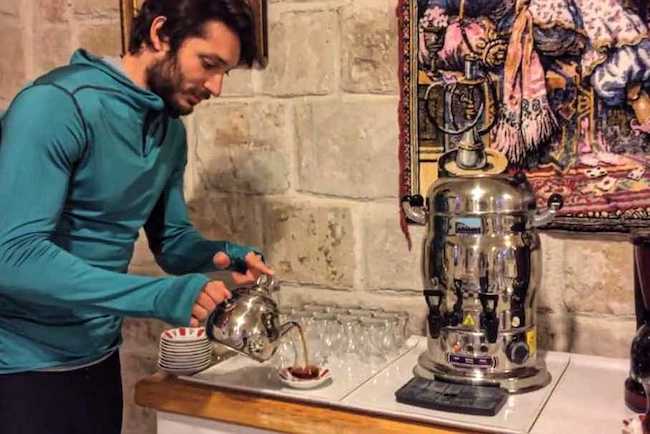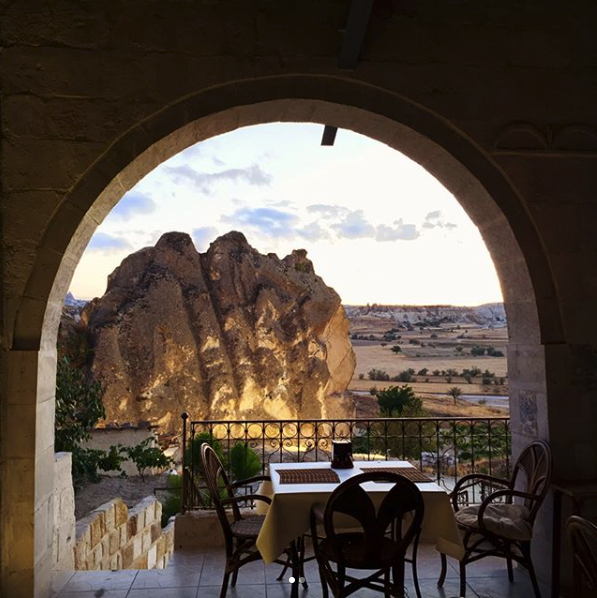I really don’t know how and where to start this article. Only thing I would like to underline before I start is that there is a lot that I would like to say out at once, but I would like to be as objective as possible. So I will try to tell everything the way they happened, without adding any opinion. Alright, if you are ready to learn what’s going on in the most totalitarian country in the world, here you go…
The tour which was planned to be 5 days actually started a day earlier in Koryo Tours office in Beijing. As everybody know, DPRK is a sensitive country on certain aspects. So we had to join a pre-tour briefing which lasted around an hour. To give a short note at this point; you must join a tour to go to DPRK, aka North Korea. You are not allowed to enter the country as a single tourist; you are not even allowed to go out of the hotel yourself. A lot were explained, but for me the real highlight was where we were taught how to fold the newspaper. James, as one of the tour guides explained how we should fold the newspaper so that the picture of leader stays flat. Otherwise is disrespectful was what we were told.

So the big day had arrived. It was 9:30 in the morning when we took the bus bound for the airport. Our visas, which were named as tourist cards were distributed on the bus. Due to diplomatic issues, DPRK doesn’t stick the visa on your passport. For the exact same reasons, they don’t stamp your passport at anytime. The small bag you see below contains a couple of stickers and a handbook for the tour. Handbook consists a basic dictionary on how to communicate simple things in Chinese and Korean, and the manual of how to fill the entry/exit, customs declaration, health inspection cards.

Frankly, what I was mostly worried about this trip was the flight itself. DPRK national carrier Air Koryo flies with Russian Tupolev airplanes instead of Airbus and Boeing, which most of us are used to. The plane is not old, and I can’t really tell the difference between it and a Boeing 737 in terms of both exterior and interior. In fact, knowing that Air Koryo is the one and only one star airliner in the world, it’s pretty intimidating. A mate from the tour called François told me that the ranking has to do with the service quality instead of safety record. He claims that Air Koryo has a clear safety record. It’s a little hard to take this as a benchmark when you consider Air Koryo is only flying to a couple of destinations though. On top of that, service quality was very good; stewardess were all pretty and smiling. The chicken burger they served was mediocre, but I have seen much worse than that. I definitely can’t say it’s a one star airliner in terms of service quality, only if that one star was given for service quality reasons…


What I’m going to talk about right now might be the most subjective part of this article, but if I don’t say out what I feel like saying out right now, I think I will have betrayed you as a reader by the time you are done reading. The flight I was afraid to take because of safety record with questions in my mind on whether the plane is old, was nothing compared to what I figured out after we landed in Pyongyang International Airport. The airplane wasn’t an airplane; it was a time machine.

The time we got out of airport, it was 1965. I’m not exaggerating, I felt like I did time travel. Buildings, streets, people, the way people wear, their hair styles etc. everything was like out of 1965. I literally couldn’t believe my eyes. Picture was even more clear when we reached the hotel; starting from the lobby, it was all 60’s.

We had our first dinner in the hotel. Food was much more tasty than I expected. Chicken, rice, fish were served one after another. I can say I was completely full after we were done eating. In the meanwhile, we finished bottles of North Korean beer. Considering we were not allowed to go out of the hotel, the best tool to kill time was alcohol. I think you can imagine the profiles of people dare joining North Korea tour. They all had very interesting backgrounds and personalities, so we had amazing times chatting and drinking. Before the night ended, we went for a game in billiard room, which was one of the countless leisure activities that the hotel provided for guests, who weren’t allowed to go out at all.

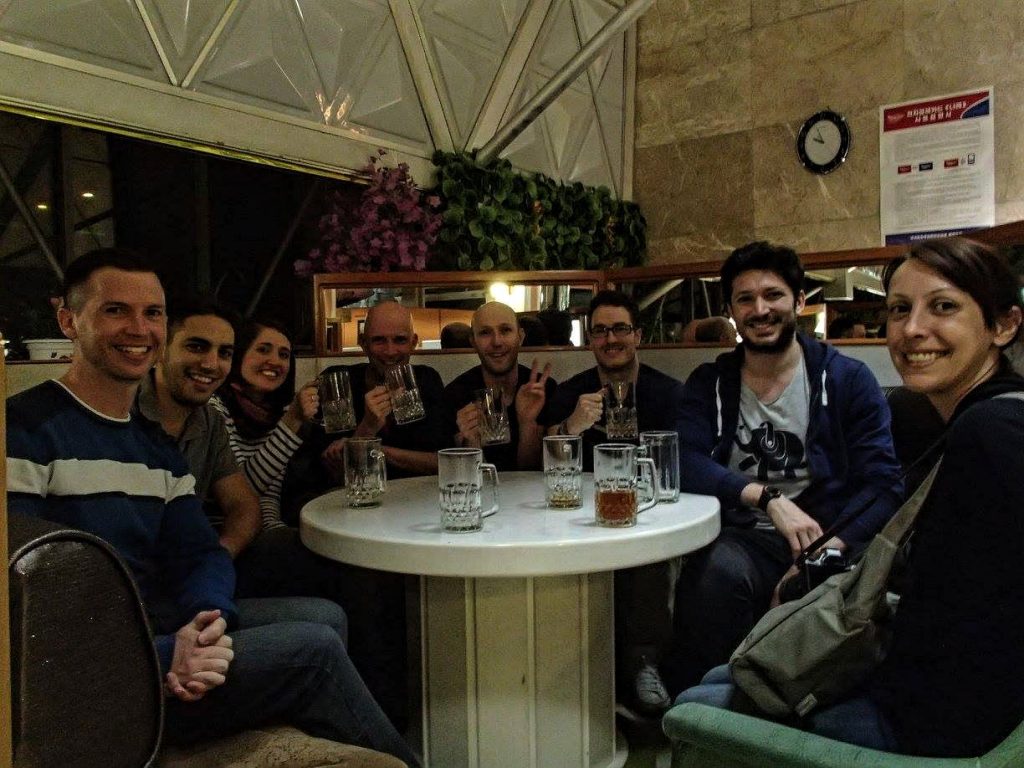

On the second day, we went to one of the most interesting spots of the trip, Kumsusan Palace of the Sun, aka mausoleum of Kim Il-Sung. The palace which was built in 1976 was initially eternal president Kim Il-Sung’s residence, but his son and successor Kim Jong-Il turned it into a mausoleum after his death in 1994. Some say renovation cost was $100m, some say $900m. As you can guess, there is no way to confirm any of these information.

If you ask what’s going on inside the palace, first of all, you have to pass a very long hallway to reach the main building. On the walls of both sides of the hallway, you can see pictures from the time country was found, till Kim Jong-Il’s death in 2011, in chronologic order. Pictures are mostly of leaders visiting different parts of the country.
Speaking of mausoleum, the palace which was renovated by Kim Jong-Il to be the eternal residence of his father, became his eternal residence too. Inside, you can see embalmed bodies of two leaders in glass caskets being shown to visitors in separate rooms. You are asked to make lines of four, then in front of each side of the casket, bow once to show respect. Putting taking pictures, bringing cameras in aside, no one is even allowed to put hands into pocket.

After we were done with our visit to Kumsusan Palace of the Sun, we went back in time to the beginning of DPRK history, where we could learn about their independence war against Japanese. Our first stop was the memorial cemetery. This cemetery was for all who sacrificed their lives for something that would be fulfilled after US and USSR declared wars against Japan in 1941 and 1945 respectively. 15 August is celebrated both in DPRK and also Republic of Korea(ROK; South Korea) as national liberation day.


After War Memorial Cemetery, next stop was a circus. Yes, you have read it right, a circus. Starting with this event, from time to time we joined certain events that weren’t directly related to DPRK visit, but somehow showing DPRK citizens were normal people, doing normal things like we do. To speak the truth, show in the circus was just amazing.

After the show, we hopped on the tram, did some sightseeing around the city, and then went up to Juche Tower, which was named after the ideology based on self-reliance. We saw the whole city from birds eye view angle.


Now is the time for the highlight of the day that makes everything even more meaningful; amusement park! If someone had said one day I would come to North Korea and hop on a rollercoaster, that’d crack me up big time. But I did! Not only rollercoaster but even bumping cars!


The day was over with dinner. We visited so many places that by the time we arrived in the hotel, no one had energy even to walk. Hearing that we have to be on the bus next morning at 7:30, we rushed to our rooms to have some rest.
On day 3, first stop was Kaesong city close to South Korea border, then Panmunjom village, where armistice agreements between DPRK and UN were held. After that we went to Demilitarized Zone between DPRK and ROK, which is also known as DMZ. On the way to Kaesong, we stopped to see Arch of Reunification, which was opened as a symbol of endless reunification debates that started on July 4th 1972. The arch was opened in 2001, and the main reason to build it was actually Presidential Joint Declaration of June 15, 2000.

After 3 hours of super bumpy bus ride, we reached Kaesong. Like most of the other spots of the tour, we went into a shop to by gifts and stuff; contribute to DPRK economy let’s say. Afterwards, a military guy, who accompanied us during Panmunjom and DMZ visits started to tell what’s what on the map.

After the briefing, we took the bus to Panmunjom. We went into cottage like buildings to see where armistice negotiations and agreement took place. We were constantly informed on how Americans and UN manipulated the process to lengthen and gain power that they lost during the war.
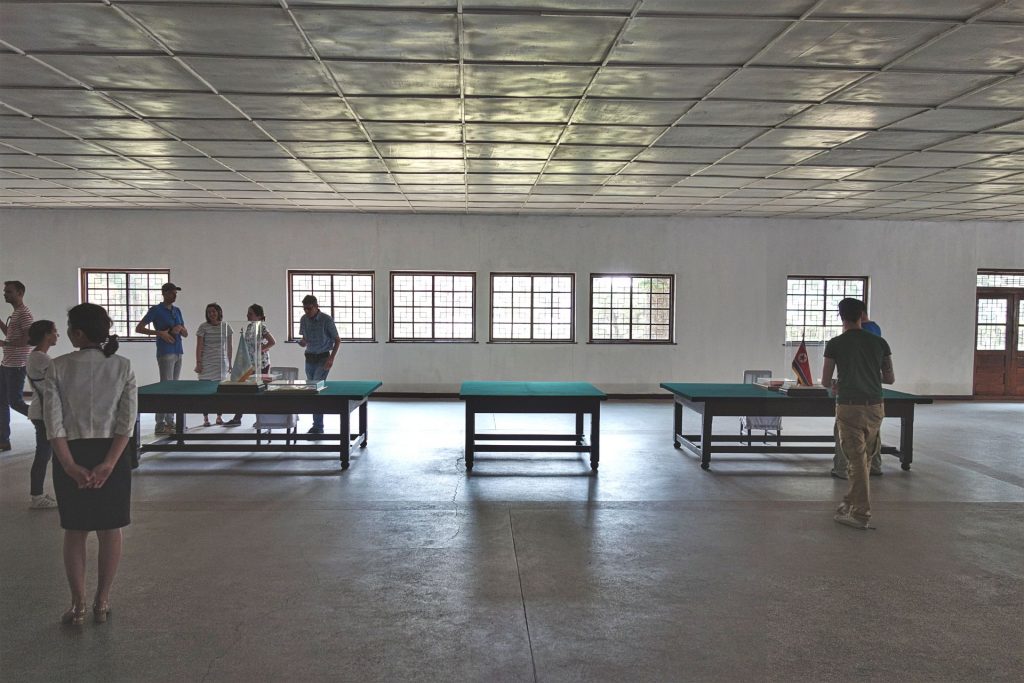

After we were done signing the armistice agreement, we were on our way to DMZ. Briefly, it was like a joint area composed of prefabricated small rooms that separates DPRK and ROK with marble line on the outside, and microphone cable on the inside. Those rooms are the places were negotiations after 1953 took place. Both sides of the area, there are observation decks for the tourists.

After we were done at DMZ, we went back to Pyongyang. It started raining half way into the ride and we found ourselves in an embroidery house. As there was nothing super interesting over there, I’m just skipping that part. So here comes the most hilarious part of the trip; flower exhibition! After the tour guide told us that we will be going to flower exhibition, my internal response was “WTF! Why are we going to flower exhibition!?” Embroidery house was like a place to sell tourist some stuff only, not really related to DPRK itself. What we saw in flower exhibition was just appaling. The place they were naming as flower exhibition was a place, where only two kinds of flowers were exhibited. Those flowers were named after the president, and his son; the general. The most intriguing part of it was that they were selling the seeds with a manual on how to cultivate. It was 5 euros for each seed. Names of the flowers? Hold on tight; Kimilsungia, and Kimjongilia.


After a dinner accompanied by bottles of beer the day was over, so we came back to the hotel. I guess last thing we did was playing cards and having fun at hotel’s cafe. It was fun.
On the morning of 4th day, we packed all our stuff and checked out of the hotel. We were supposed to be in Pyongyang in the daytime, then in the evening we would be off to a city called Nampo. Nampo was a couple of hours bus ride from Pyongyang, and the reason why we were going there was a hot spa hotel. First stop of the day was Pyongyang Metro.

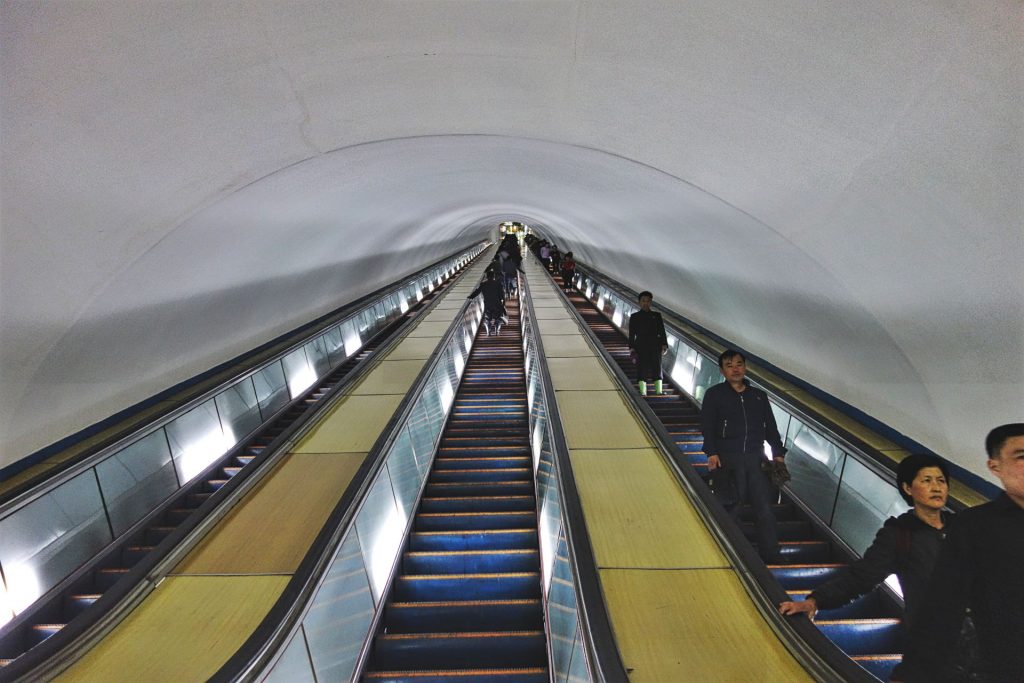

The subway has 2 lines and 17 stops in total. You can see how Soviet style fancy everything is. This style is almost identical to the one I saw in Kiev, Ukraine. We hopped on the train, passed one station, got out, checked out that station and hopped back on again. The last stop was at one of the symbols of Pyongyang; The Arch of Triumph.

The most intriguing thing I experienced in metro was at the time we got out of the car you see on the above picture, and then hopped on a modern one like we have in western countries. Today as you know, most of the cars in metro have those little screens that mostly show commercials and stuff. In Pyongyang Metro, it was showing footage from different parts of the country on how things were going well, and narration was exactly nightclub sound level. I’m not exaggerating, I wasn’t able to make the person next to me hear what I was talking about.
Next stop that was worth talking about was Mangyongdae Children’s Palace. We went to an art gallery, and then a shooting range before that, but I’m skipping those as they weren’t super interesting. Children’s Palace was definitely worth talking about. The palace was designed for children to be engaged in extra-curricular activities like music, painting, embroidery and so on. The show that they performed for 45 minutes was flawless. I don’t know how they educate, or train these kids, but they were as perfect as German engineering. What really appalling was that they kept showing nuclear test videos on the big screen behind them while they were performing. Showing missile launch videos during the performance of kids below age 15 is something that’d only happen in DPRK I guess.




We headed to the hot spa place where we were supposed to spend the night. Before I start talking how hot spa was, actually how it wasn’t, I would like to say something about what we saw on the way there. As we were in the bus and it was super dark outside, I couldn’t take a lot of pictures, but the houses by the road had no electricity at all. It was dark, windy, super cold. When you think of how people survive in those houses, it makes you feel very uncomfortable. Coming back to the hot spa, I can say it looks like anything but hot spa. The one in our room didn’t even work at all, something was wrong with the tap I guess. Outside is another horror story; cold, dark, no one at all… On top of that, we lost the way back home after dinner, it was tragicomic.
Fifth and the last day, we woke up early in the morning as usual and went to Nampo Dam, also known as West Sea Barrage. We went up to some hill that we could see the dam from the top. They also showed some footage about how it was built, but I passed out thanks to rock hard bed from previous night. The video was about how they built a dam at the end of the day, no rocket science behind. We clicked a couple of pictures and moved on.


Right after the dam, we went to somewhere called cooperative farm. The most interesting thing we saw there was a small kindergarden. Little kids played games with us, made us dance with them. I can’t describe how cute day were.


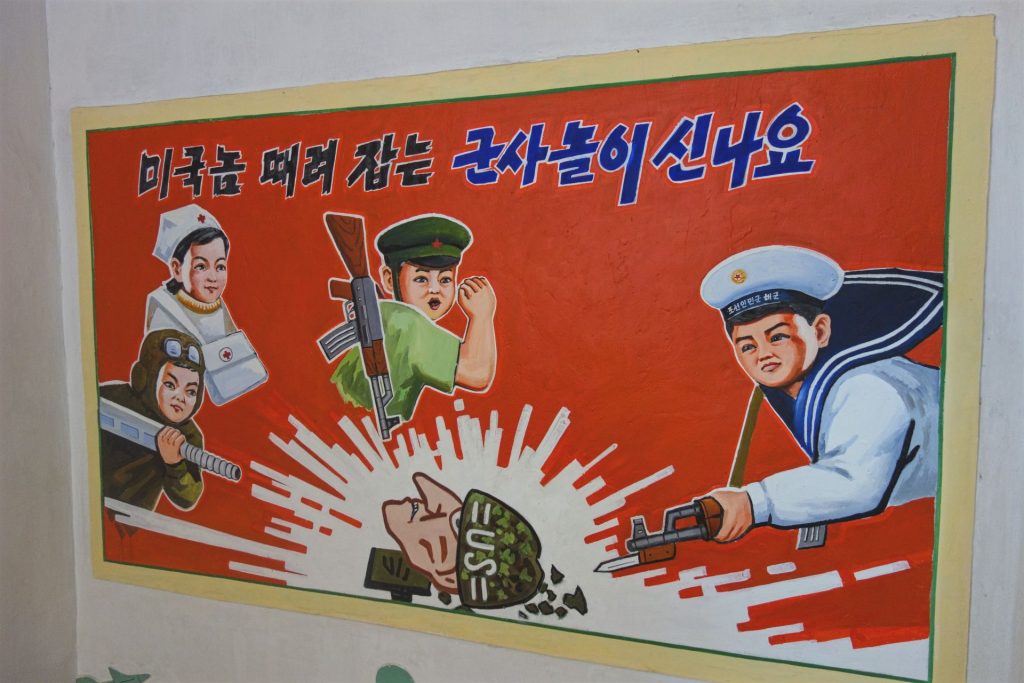
Now is the time to tell you about “on the spot guidance”. Wherever you go in DPRK, you can see Kim Il Sung, Kim Jong Il, or even both of them on the pictures. On most of these pictures, at least one of the leaders is pointing at somewhere, trying to show something. This is what’s called “on the spot guidance” by North Koreans, as well as DPRK mass media. Briefly, it’s telling people what and how to do things, on the spot. What you see on the below picture is two middle easterners giving on the spot guidance to the workers in mineral water factory.


What was left for the day and the whole trip was Mansu Hill Monuments, War Museum, and Workers Party Monument. Interesting experience here was that as a result of rehearsals for the upcoming Workers Party congress, our bus got stuck and we had to walk through the crowd. I can’t share pictures of people on the streets as we weren’t allowed to take close shots. Only thing I would like to say here is that there were thousands, ten thousands of them on the streets, and one could easily read on their faces that they were bored a lot.


After Mansu Hill Monuments, we went to War Museum. We weren’t allowed to take pictures inside, but I can definitely say it was one of the best designed museums I have ever been. They made us feel the Korean War thoroughly. There was one part that we were in a room, where the platform under us was turning 360 degrees and we watched what happened on the war with some special effects on painted walls. It was literally amazing; I haven’t seen such thing in another museum so far.
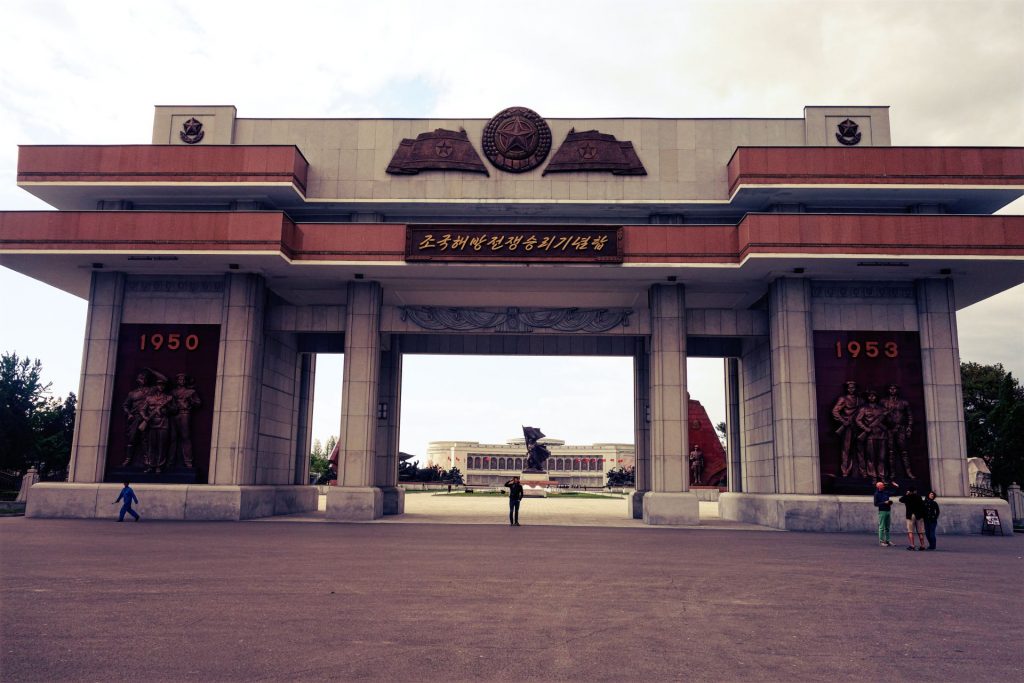
Before I share Workers Party Monument and some last shots from the trip, I would like to sum up my feelings. DPRK trip probably wasn’t the most relaxing, most fun, most pleasant trip I have ever been. In fact, without a seconds hesitation, it was one of the most interesting things I have ever done. Even staying out of telephone, internet, outside world were different experiences. I saw a world over there that you can’t see anywhere else. I learned how grateful I should feel for what I have. I’m so glad that I took the once in a lifetime chance and visited this country.



Hope you liked the post. For all your questions and whatnot, you can either e-mail me over bt@berkaytekin.com, or contact me through my social media accounts.
Instagram: http://www.instagram.com/betekin
Facebook: http://www.facebook.com/teberkay
Till next!








